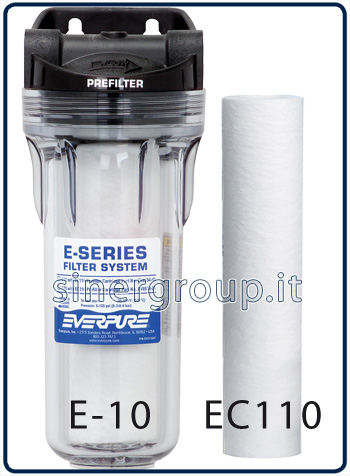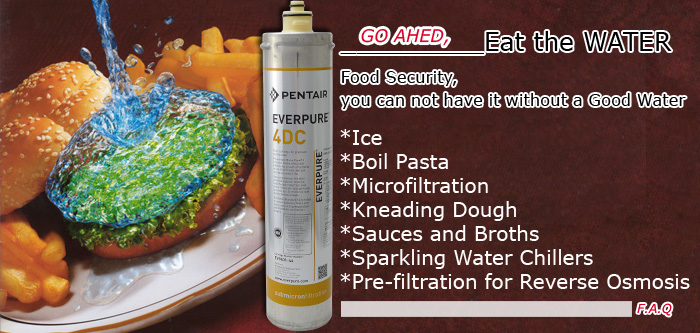WATER QUALITY FACTS YOU NEED TO KNOW
Consumers know more about water than even before.
Consumers rely on restaurants to provide them with the same wholesome food and safe water they use at home. Fifty billion meals eaten in reataurants, schools and cafeterias each year, and almost half of all adults were restaurant patrons on a typical day in 1995, according the National Restaurant Association (NRA).
MAKE TIME TO TEST YOUR WATER
Half the battle in protecting consumers from harmful contaminants and serving clear, good-tasting water, is learning exactly what contaminants are in your water supply. Once you know, selecting a water filtration system to address the problems will be easy.
All municipal water treatment plants are required to provide business owners and residents. These reports, in part, will provide you with a list of drinking water violations that have occurred in the past year and levels of contaminants in the water supply.
What those reports won't show, however, is the quality of the water coming directly out your faucets or running through your equipment. Water distribution pipes leading from most of the nation's treatment plants often allow rust, lead and other corrosive metals to contaminate previously treated water. Worse yet, despite increased vigilance from municipalities. And all are completely preventable with an appropriate water filtration system.
ALWAYS LOOK FOR NFS CERTIFICATION
There are many water filtration systems on the market. It's important to know what you're buying and what performance you can expect from a system.
Water filtration systems have only one quality assurance standard - NSF Certification. NSF International, the indipendent testing agency that sets product standards for water filtration manufactured, established its Drinking Water Treatment Unit Certification Program to determine if a water filtration system performs in the marketplace as tested. Manufacturers voluntarily submit products to NSF to receive third-party certification of their systems and performance.
The materials of contruction do not add anything to the water, the system is structurally sound and that advertising claims are true and accurate. NSF has developed a series of standards to reflect various level of filtration. NSF Standard 53 is the highest standard available for protection from health hazards such as lead and cysts. Choosing a water filtration system with a rating of NSF 53 is like an insurance policy against these potential contaminants.
SAY GOODBYE TO NSF ASSURANCES WHEN CHOOSING "WILL FIT" ALTERNATIVES
When a manufactures states on its packaging and advertisement that its product "fits," "can be used," or "can replace" another manufacturer's element in the field, implying the system maintains its NSF Certification, your operation and your customers may be at risk. According to NSF, once you've installed a system, using another brand of replacement cartridge makes NSF certification of either the system or the cartridge null and void.
For example, if you purchase a system certified by NSF for removal of Cryptosporidium, then purchase another manufaturer's replacement cartridge because the packaging states it will "fit" the housing of the original system, the certification is void. There is no way to determine if the filter does what it claims because it has never been tested.
In water filtration, as with any high performance product, you get what you pay for. Often, the less expensive filters remove fewer contaminants, provide lower levels of performance and are, in general, less reliable. Mixing and matching cartridges is a risk game. Factors that impact the ultimate performance of a water filtration system - sealing mechanisms (o-rings, gaskets, spacers), flow restrictors and tubing to limit flow - must be carefully calibrated to assure maximum performance. If the "fit" of a filter isn't exact, harmful cysts, sediment and other contaminants not removed by water treatment plants may pass through these microspic openings and infect the water in your operation.
ALL FILTERS ARE NOT CREATED EQUAL
It's easy to get lost in the jungle of filters and technology. Granular activated carbon. Carbon block. Precoat. Reverse osmosis. Even water softeners. To make an educated choice on the type of water treatment you require, follow three steps:
1) Determine what is in your water.
2) Understand the technologies available to you.
3) Select the most cost-effective solution for your needs.
We can assist you with all these steps.
Here's a brief overview of the most popular water treatment technologies.
Precoat filtration is a very reliable way to remove particulate contaminants, off-tastes and odors. The unique precoat design consists of a material folded over a drainage grid, all of which serves as support for a coat blend of powdered activated Carbon and other filtering materials. An exclusive technology available only from EVERPURE, precoat filters provide a longer filter life and remove 99,9% of all particles 1/2-micron and larger.
"Granular activated carbon" (GAC), filters consist of a housing filled with loose activated Carbon granules. The activated Carbon (AC) surface attracts and holds molecules such as those that cause poor tastes and odors. Better systems can reduce other contaminants, such as lead. These lower-priced system do not "fine-filter" the water and therefore are not as effective as other products in removing particulates and cysts.
"Carbon Block" è is activated Carbon mixed with chemical binders to form a hard block of a Carbon, which is then cut and shaped to fit the filtering housing. Sediment removal is dependent on the micron rating. Higher Carbon content remove odors and off-tastes. There are submicron Carbon block filters that remove smallersized particles, providing cyst reduction. These filters must be handled carefully as they can crack, causing an undetectable contaminant bypass.
"Reverse osmosis" (RO) systems use pressure to force water molecules through a membrane, causing contaminants to be left behind and separated from the water. These system are very effective, especially for removal of heavy metals, nitrate, fluoride and pesticides. But they are more expensive both in terms of equipment and maintenance cost than other systems. They are also limited in their ability to produce product water over a given period of time. Due to these critical factor, it is important to verify that your ester quality requires RO.
Water softeners, which condition the water through an ion exchange process, are at time confused with filtration. Water softeners are primarily used to reduce the mineral content (hardness) in water. They do not produce "ingredient" water, free of tastes and odors, particulates, certain other contaminants and cysts. To produce quality ingredient water, other equipmentis required.
GOOD QUALITY WATER MAKES GOOD ECONOMIC SENSE, TOO
Protecting your customers from water and foodborne illnesses isn't the only reason high quality water makes sense. Fountain dispensers, ice machine and coffemakers typically consume a combined two or three gallons of water per minute and are considered the backbone of any good foodservice operation.
Protecting your investment in costly, but absolutely necessary, foodservice equipment by filtering the water can't help but boost the bottom line.
Mineral scale builds up on heating elements, ice machine evaporator plates and other key components in coffee and espresso machines. It can also cause havoc with fountain beverage dispensers, ice machines, steamers and dishwashing equipment. Poor quality water can cause equipment to work harder, consume more electricity and fail prematurely.
Industry research by ice maker manufacturers shows that two-thirds of all foodservice equipment maintenance costs are water-related and can easily be prevented. A high quality water filtration system will not only help an operation address food and water safety issues, but can reduce scale buildup and the need for service calls and frequent equipment replacement.
Many of today's most profitable, well-maintained foodservice operations know that removing dirt and other abrasive particles that consistently damage the internal working of foodservice equipment, such as water distribution lines and pumps, isn't optional, it's essential.
IT'S EASY TO HAVE GOOD WATER AND GOOD FOOD
Your customers may take it for granted that he water in your operation is as safe as it can be.
Unfortunately, in this litigious society, you don't have the luxury of taking water safety for granted. It only takes one waterborne outbreak to close down a business.
Smart operators are also making customers, aware of food - and water - safe pratices. Conumers already know the risk, so promote the action you're investing in to ensure their safety. Assure them it's ok to not only eat the water, but everything else in which water is an ingredient in your operation.
Notice: The contaminants removed or reduced by this system are not necessarily in your water.



